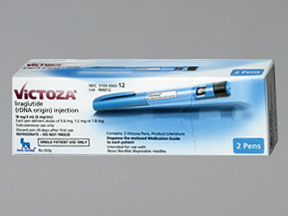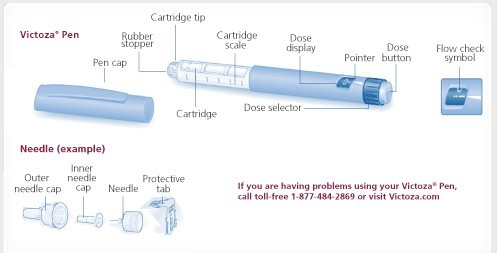|
利拉鲁肽是一种人胰高糖素样肽-1(GLP-1)类似物,用于治疗糖尿病。
【商品名】:诺和力(Victoza) 。
【药品名称】:利拉鲁肽注射液
【英文名称】:Liraglutide injection
【汉语拼音】:Lilalutai Zhusheye
【成份】
分子量:3751. 20 Da
其他成份:二水合磷酸氢二钠、丙二醇、盐酸和/或氢氧化钠(仅作为pH调节剂)、苯酚和注射用水。
【性状】
本品为无色或几乎无色的澄明等渗液;pH=8. 15。
【适应症】
本品用于成人2型糖尿病患者控制血糖:
适用于单用二甲双胍或磺脲类药物最大可耐受剂量治疗后血糖仍控制不佳的患者,与二甲双胍或磺脲类药物联合应用。
【用法用量】
用法
本品每日注射一次,可在任意时间注射,无需根据进餐时间给药。本品经皮下注射给药,注射部位可选择腹部、大腿或者上臂。在改变注射部位和时间时无需进行剂量调整。然而,推荐本品于每天同一时间注射,应该选择每天最为方便的时间。更多有关给药的指导参见使用及其他操作的注意事项。
本品不可静脉或肌肉注射。
用量
利拉鲁肽的起始剂量为每天0. 6mg。至少1周后,剂量应增加至1. 2mg。预计一些患者在将剂量从I.2mg增加至1. 8mg时可以获益,根据临床应答情况,为了进一步改善降糖效果,在至少一周后可将剂量增加至1. 8mg。
推荐每日剂量不超过1. 8mg。
本品可用于与二甲双胍联合治疗,而无需改变二甲双胍的剂量。
本品可用于与磺脲类药物联合治疗。当本品与磺脲类药物联用时,应当考虑减少磺脲类药物的剂量以降低低血糖的风险(见注意事项)。
调整本品的剂量时,无需进行自我血糖监测。然而,当本品与磺脲类药物联合治疗而调整磺脲类药物的剂量时,可能需要进行自我血糖监测。
【不良反应】
在5项大规模的长期临床试验中,己有超过2500例患者接受了本品单药治疗或本品与二甲双胍、磺脲类药物(加或不加二甲双胍)或二甲双胍加罗格列酮联合治疗。
不良反应发生的频率定义如下:非常常见(,1/10);常见(,1/100, <1/10>:少见不良反应(,1/1, 000, <1/100),罕见不良反应(,1/10, 000, <1/1, 000);非常罕见不良反应(<1/10, ooo> ;不详(根据现有的数据无法评价)。在每个频率分组中,不良反应都是按照严重性降低的顺序列出。
临床试验期间最常见的不良反应为胃肠道不适:恶心和腹泻非常常见,呕吐、便秘、腹痛和消化不良常见。在本品治疗的开始阶段,这些胃肠道不良反应发生频率可能更高。上述不良反应通常在治疗持续数天或数周内减轻。头痛和上呼吸道感染也是常见不良反应。此外,低血糖事件为常见不良反应,而当本品与磺脲类药物联用时则非常常见。重度低血糖主要发生在本品与磺脲类药物联用时。
表1列出了本品III期临床研究中确定的相关不良反应。该表列出的不良反应的发生率均>5%,且其在本品治疗组患者中的发生率均高于在对照组中的发生率。该表中还包含了发生率>=1%、且在本品治疗组患者中的发生率大于其在对照组中发生率的2倍的不良反应。
表1III期对照临床研究中报告的不良反应发生频率
在一项本品单药治疗的临床试验中,本品治疗组低血糖的发生率低于活性对照组(格列美脲)。最常见的不良事件为胃肠道疾病以及感染与侵染。
低血糖
临床研究中大部分确认的低血糖事件均为轻度。未在本品单药治疗的研究中观察到重度低血糖事件。重度低血糖比较罕见,主要发生在本品与磺脲类药物联用时(0. 02事件/患者年)。本品与磺脲类药物之外的口服抗糖尿病药物合用时所观察到的低血糖事件非常少(0. 001事件/患者年)。
大部分恶心均为轻至中度,呈一过性,且很少会导致治疗停止。
图1各周出现恶心不良事件的受试者百分比-长期试验
当本品与二甲双胍联用时,20. 7%的患者至少报告了1次恶心事件,12. 6%的患者至少报告了1次腹泻事件。当本品与磺脲类药物联用时,9. 1%的患者至少报告了1次恶心事件,7. 9%的患者至少报告了1次腹泻事件。大部分事件均为轻至中度,且呈剂量依赖性。大部分最初出现恶心症状患者在继续治疗情况下,这些症状的频率和严重程度均有所降低。
70岁以上患者接受本品治疗时,可能会出现更多的胃肠道反应。
轻度肾功能损害(肌酐清除率<=60-90ml/min)的患者接受本品治疗时,可能会出现更多的胃肠道反应。
退出
在长期(26周或更长)对照试验中,本品治疗组患者中由于不良反应导致的退出率为7. 8%,而在对照组患者中为3. 4%。本品治疗组中最常见的导致退出的不良反应为恶心(2. 8% )和呕吐(1.5%) 。
免疫原性
与其他含蛋白质或肽类的药物可能具有免疫原性相一致,患者在接受本品治疗之后可能会产生抗利拉鲁肽抗体。平均有8. 6%的患者会产生抗体。抗体形成不会导致本品疗效的降低。
注射部位反应
在长期(26周或更长)对照试验中,约2%接受本品的受试者报告了注射部位反应。这些反应通常都为轻度,而且不会导致停用本品。
胰腺炎
在本品长期临床试验期间已经报告了少数(<0. 2%)急性胰腺炎病例。本品与胰腺炎之间的因果关系尚不明确。
甲状腺事件
在所有中、长期临床试验中,全部利拉鲁肽、安慰剂和全部对照药组中甲状腺不良事件的总体发生率分别为33. 5, 30. 0和21. 7事件/1000患者年;而严重甲状腺不良事件的发生率分别为5. 4. 2. 1和0. 8事件/1000患者年。
在本品治疗组患者中,甲状腺肿瘤、血降钙素升高和甲状腺肿是最常见的甲状腺不良事件,其发生率分别为0. 5%, 1%和0. 8%。
【禁忌】
对本品活性成份或者本品中任何其他辅料过敏者
【注意事项】
本品不得用于1型糖尿病患者或用于治疗糖尿病酮症酸中毒。
本品不得用于有甲状腺髓样癌(MTC)既往史或家族史患者以及2型多发性内分泌肿瘤综合征患者(MEN 2)。
本品在纽约心脏病学会(NYHA)分级I- II级的充血性心力衰竭患者中的治疗经验有限。尚无在NYHA分级III一IV级的充血性心力衰竭患者中应用的经验。
在炎症性肠病和糖尿病性胃轻瘫患者中的治疗经验有限,因此不推荐本品用于这些患者。
本品治疗过程中会伴随有一过性的胃肠道不良反应,包括恶心、呕吐和腹泻。
已经发现使用其他GLP-1类似物与发生胰腺炎风险相关。
已有少数急性胰腺炎的报道。应当告知患者急性胰腺炎的特征性症状:持续、严重的腹痛。如果怀疑发生了胰腺炎,应该停用本品和其他潜在的可疑药物。
一些临床试验已经报告了包括血降钙素升高、甲状腺肿和甲状腺肿瘤在内的甲状腺不良事件,尤其是在之前患有甲状腺疾病的患者中(见不良反应)。接受本品联合磺脲类药物治疗的患者发生低血糖的风险可能增加(见不良反应)。减少磺脲类药物的剂量可以降低低血糖的风险。
对驾驶和机械操作能力的影响
尚未研究本品对驾驶和机械操作能力的影响。应告知患者在驾驶和操作机械时预防低血糖发生,特别是当本品与磺脲类药物合用时。
使用和其他操作的特别注意事项
本品仅在呈无色澄明时才可使用。
本品不得在冷冻后使用。
本品应与长至8mm以及细至32G的诺和针,配合使用。
本品不包含注射针头。
【特殊人群】
肾功能损害:轻度肾功能损害的患者不需要进行剂量调整。在中度肾功能损害患者中的治疗经验有限。目前不推荐本品用于包括终末期肾病患者在内的重度肾功能损害患者(见药代动力学)。
肝功能损害:在肝功能损害患者中的治疗经验有限,因此不推荐本品用于轻、中、重度肝功能损害患者(见药代动力学)。
【孕妇及哺乳期妇女用药】
妊娠
目前尚无本品用于奸娠妇女的充分数据。
动物研究已经表明本品具有生殖毒性(见临床前安全性数据)。
本品对人类的潜在风险尚不清楚。本品不得在妊娠期间使用,此时推荐使用胰岛素。如果患者在治疗期间计划怀孕或已经怀孕,应停止本品治疗。
哺乳
利拉鲁肽是否在人乳中分泌,尚不清楚。动物研究已经表明,利拉鲁肽及其结构上紧密相关的代谢产物在乳汁中出现的比例很低。由于缺少相关经验,本品不得在哺乳期内使用。
【儿童用药】
由于缺乏相关数据,不推荐本品用于18岁以下儿童和青少年。
【老年用药】
根据一项在健康受试者中进行的药代动力学研究,以及对患者(18至80岁)的群体药代动力学数据分析的结果,年龄不会对利拉鲁肽的药代动力学产生与临床相关的影响。因此,不需要根据年龄进行剂量调整。在年龄必75岁患者中的治疗经验有限。
【药物相互作用】
在体外研究中已经证实,利拉鲁肽和其他活性物质之间发生与细胞色素P450和血浆蛋白结合有关的药代动力学相互作用的可能性极低。
利拉鲁肽对胃排空的轻度延迟可能会影响同时口服的其他药物的吸收。相互作用研究并未表明药物的吸收出现了任何与临床相关的延迟。少数经本品治疗的患者至少报告了1次严重腹泻事件。
腹泻
可能会影响同时口服的药物的吸收。
扑热息痛
利拉鲁肽不会改变扑热息痛单次给药1000mg之后的总体暴露。扑热息痛的峰浓度(Cmax)降低了31%,而达峰时间(Tmax)中位数延迟了15分钟。与扑热息痛联用时不需要进行剂量调整。
阿托伐他汀
利拉鲁肽对阿托伐他汀单次给药40mg之后的总体暴露没有产生具有临床意义的改变。因此,阿托伐他汀与本品联用时不需要进行剂量调整。在利拉鲁肽的作用下,阿托伐他汀的峰浓度(Cmax)降低了38%,而中位达峰时间(Tmax)从1小时延长至3小时。
灰黄霉素
利拉鲁肽不会改变灰黄霉素单次给药500mg之后的总体暴露。灰黄霉素的峰浓度(CmaX)增加了37%,而达峰时间(Tmax)中位数未发生变化。灰黄霉素和其他低溶解度和高渗透性的药物与本品联用均不需要进行剂量调整。
赖诺普利和地高辛
单次给予赖诺普利20mg或地高辛1mg同时给予利拉鲁肽之后,赖诺普利和地高辛的药时曲线下面积(AUC)分别降低了15%和16%:峰浓度(Cmax)分别降低了27%和31%。利拉鲁肽使赖诺普利的达峰时间(Tmax)中位数从6小时延长至8小时;而地高辛的达峰时间(Tmax)中位数从1小时延长至1. 5小时。根据上述结果,不需要对赖诺普利或地高辛的剂量进行调整。
口服避孕药
单次给予一种口服避孕药之后,利拉鲁肽分别使乙炔雌二醇和左炔诺孕酮的峰浓度(Cmax)降低了12%和13%。利拉鲁肽使两种成份的达峰时间(Tmax)皆延长了1. 5小时。对乙炔雌二醇或左炔诺孕酮的总体暴露没有产生具有临床意义的影响。因此,联用利拉鲁肚预期不会影响口服避孕药的避孕效果。
华法林
尚未进行任何药物相互作用研究。接受华法林治疗的患者开始接受本品治疗后,推荐进行更为频繁的INR(国际标准化比值)监测。
胰岛素
尚未对本品与胰岛素联用进行评价。
配伍禁忌
添加至本品的物质可能会导致利拉鲁肽的降解。在未进行配伍禁忌研究的情况下,本品不得与其他药品混合。
【药物过量】
在本品的一项临床研究中,1例2型糖尿病患者发生了单次皮下注射17. 4mg(最大推荐维持剂量1. 8mg的10倍)的用药过量事件。药物过量导致了严重恶心和呕吐,但未发生低血糖。患者恢复并且没有出现并发症。
如果发生药物过量,应当根据患者的临床体征和症状采取适当的支持治疗。
【药理毒理】
药理作用
利拉鲁肽是一种GLP-1类似物,与人GLP-1具有97%的序列同源性,人GLP-1可以结合并激活GLP-1受体。GLP-1受体为天然GLP-1的靶点,GLP-1是一种内源性肠促胰岛素激素,能够促进胰腺β细胞葡萄糖浓度依赖性地分泌胰岛素。与大然GLP-1不同的是,利拉鲁肽在人体中的药代动力学和药效动力学特点均适合每天一次的给药方案。皮下注射给药后,其作用时间延长的机理包括:使吸收减慢的自联作用;与白蛋白结合;对二肽基肽酶IV (DPP-IV)和中性内肽酶(NEP)具有更高的酶稳定性,从而具有较长的血浆半衰期。
利拉鲁肽的活性由其与GLP-1受体间特定的相互作用介导,导致环磷酸腺苷(cAMP)的增加。利拉鲁肽能够以葡萄糖浓度依赖的模式刺激胰岛素的分泌,同时以葡萄糖浓度依赖的模式降低过高的胰高糖素的分泌。因此,当血糖升高时,胰岛素分泌受到刺激,同时胰高糖素分泌受到抑制。与之相反,在低血糖时利拉鲁肽能够减少胰岛素分泌,且不影响胰高糖素的分泌。利拉鲁肽的降血糖机理还包括轻微延长胃排空时间。利拉鲁肽能够通过减轻饥饿感和能量摄入降低体重和体脂量。
【药效学效应】
利拉鲁肽的作用持续时间为24小时,能够通过降低2型糖尿病患者的空腹及餐后血糖而改善血糖控制。
在2型糖尿病患者中,单次给予利拉鲁肽可以观察到胰岛素分泌率以葡萄糖浓度依赖的模式增加(图4)。
图4 2型糖尿病患者(N=10)单次接受7. 5 ug/kg(约0. 7mg)的利拉鲁肽或安慰剂后,在逐级递增的葡萄糖输注期间的平均胰岛素分泌率(ISR)与葡萄糖浓度.
【毒性研究】
遗传毒性:遗传毒性研究数据显示,利拉鲁肽对人体没有特殊危害。
生殖毒性:动物研究并未显示出利拉鲁肽会对生育力会产生直接的有害作用,但是在最高剂量下会轻度增加早期胚胎的死亡率。孕中期给予利拉鲁肽可以导致母体动物体重下降和胎仔生长减慢,并伴有意义不明的大鼠肋骨及家兔骨骼变异。大鼠接受利拉鲁肚后新生仔鼠的生长减慢,且高剂量组在断乳期后此效应仍然存在。尚不清楚新生仔鼠生长减慢系因为直接GLP-1效应导致新生仔摄取母
乳量减少,或者因为热量摄取减少导致母乳产量下降所致。
致癌性:在大鼠和小鼠为期2年的致癌性试验中观察到非致死性的甲状腺C细胞肿瘤。在大鼠中,未观察到未见不良反应的剂量水平(NOAEL)。猴在接受20个月的给药后未观察到这些肿瘤。在啮齿类动物中的这些发现系一种非遗传毒性的、GLP-1受体介导的特定作用所致,啮齿类动物对该作用尤为敏感。此作用与人体的相关性可能较低,但是不能完全排除。未发现其他与给药相关的肿瘤。
【药代动力学】
吸收
利拉鲁肽经皮下注射后的吸收比较缓慢,在给药后8-12小时达到最大浓度。单次皮下注射利拉鲁肽0. 6mg之后,利拉鲁肽的最大浓度估计值为9. 4nmol/L。在1. 8mg的利拉鲁肽剂量水平下,利拉鲁肽的平均稳态浓度(AUC1/24)达到约34nmol/L。利拉鲁肽的暴露程度随剂量成比例增加。单次给予利拉鲁肽,药时曲线下面积((AUC)的个体内变异系数为11%。
利拉鲁肽皮下注射后的绝对生物利用度约为55%。
分布
皮下注射后的表观分布容积为11-17L。
利拉鲁肽静静脉注射后的平均分布容积为0. 07L/kg。利拉鲁肽可与血浆蛋白广泛结合(>98% )。
代谢
单次给予健康受试者放射标记的[3H」一利拉鲁肽的24小时内,血浆中的主要成分为利拉鲁肽原型药物。检测到两种少量血浆代谢产物(分别为总血浆放射性暴露的<=9%和<=5%)。利拉鲁肽以一种与大分子蛋白类似的方式进行代谢,尚无特定器官被确定为主要的消除途径。
消除[3H」-利拉鲁肽给药后,在尿液和粪便中没有检测到完整的利拉鲁肽。所给予的放射性中仅有少部分作为利拉鲁肽相关的代谢产物经尿液或粪便排泄(分别是6%和5%)。尿液和粪便中的放射性主要在前6-8天内排泄,分别对应于三种少量的代谢产物。
利拉鲁肽单次皮下注射后的平均清除率约为1. 2L/小时,消除半衰期约为13小时。
特殊人群
性别:对男性及女性患者的群体药代动力学数据分析结果以及一项在健康受试者中进行的药代动力学研究结果显示,性别不会对利拉鲁肽的药代动力学产生具有临床意义的影响。
种族来源:一项包含白人、黑人、亚洲人和西班牙人受试者的群体药代动力学分析的结果显示,种族差异不会对利拉鲁肽的药代动力学产生与临床相关的影响。
肥胖:群体药代动力学分析提示,体重指数(BMI)不会对利拉鲁肽的药代动力学产生显著影响。
肝功能损害:一项单次给药临床试验评价了利拉鲁肽在不同程度肝功能损害受试者中的药代动力学。与健康受试者相比,轻至中度肝功能损害受试者的利拉鲁肽暴露降低了13-23%。重度肝功能损害(Child Push评分>9)受试者的利拉鲁肽暴露显著降低(44%)。
肾功能损害:与肾功能正常的受试者相比,肾功能损害受试者的利拉鲁肽暴露降低。轻度(肌酐清除率,CrCL 50-80ml/min)、中度(CrCL 30-50ml/min)以及重度(CrCL<30m1/min)肾功能损害和需要透析的终末期肾病受试者的利拉鲁肽暴露分别降低了33%, 14%, 27%和28%。
【贮藏】
本品应冷藏于2 0℃-8℃冰箱中(勿接近冰箱的冷冻室)。
不可冷冻。
首次使用后,应在30℃以下贮藏或冷藏在2 0℃-8℃冰箱中,盖上笔帽避光保存。
应当告知患者在每次注射后按照当地的要求丢弃注射针头,这可以避免污染、感染和渗漏,同时能确保给药准确。
【规格】3ml:18mg(预填充注射笔)。
【包装】
本品为可调节剂量、一次性预填充注射笔,由笔型注射器和装有3ml液体的笔芯组成。笔芯由1型玻璃制成,内有一个活塞(嗅丁基橡胶),并由一个橡胶塞(嗅丁基橡胶/聚异戊二烯橡胶)密封。
笔型注射器由聚烯烃和聚缩醛制成。
每支笔含有3ml溶液,可以进行30次0.6mg,15次1.2mg或10次1. 8mg注射。 【包装规格】:每盒1支;每盒2支。
【有效期】
30个月。
【执行标准】
进口药品注册标准:JS20090155。
【生产企业】
丹麦诺和诺德公司(Novo Nordisk A/S)

Using the Victoza® Pen
Victoza® Patient Instructions for Pen Use Video
Learn how to deliver a dose of Victoza®.
View video
Victoza® User’s Guide
Get the latest information about Victoza®, product availability, and more.
View User’s Guide
Enlarge
First read the Medication Guide that comes with your Victoza® Pen and then read these Patient Instructions for Pen Use for information about how to use your Victoza® Pen the right way.

These instructions do not take the place of talking with your healthcare provider about your medical condition or your treatment.
Your Victoza® Pen contains 3 mL of Victoza® and will deliver doses of 0.6 mg, 1.2 mg, or 1.8 mg. The number of doses that you can take with a Victoza® Pen depends on the dose of medicine that is prescribed for you. Your healthcare provider will tell you how much Victoza® to take.
Victoza® Pen should be used with Novo Nordisk disposable needles. Talk to your healthcare provider or pharmacist for more information about needles for your Victoza® Pen.
Important Information
Do not share your Victoza® Pen or needles with anyone else. You may give an infection to them or get an infection from them.
Always use a new needle for each injection.
Keep your Victoza® Pen and all medicines out of the reach of children.
If you drop your Victoza® Pen, repeat “First Time Use For Each New Pen” (steps A through D).
Be careful not to bend or damage the needle.
Do not use the cartridge scale to measure how much Victoza® to inject.
Be careful when handling used needles to avoid needle stick injuries.
You can use your Victoza® Pen for up to 30 days after you use it the first time.
First Time Use for Each New Pen
Step A. Check the Pen
Take your new Victoza® Pen out of the refrigerator.
Wash hands with soap and water before use.
Pull off pen cap.
Check Victoza® in the cartridge. The liquid should be clear, colorless and free of particles. If not, do not use.
Wipe the rubber stopper with an alcohol swab.
Step B. Attach the Needle
Remove protective tab from outer needle cap.
Push outer needle cap containing the needle straight onto the pen, then screw needle on until secure.
Pull off outer needle cap. Do not throw away.
Pull off inner needle cap and throw away. A small drop of liquid may appear. This is normal.
Step C. Dial to the Flow Check Symbol
Turn dose selector until flow check symbol (--) lines up with pointer.
Step D. Prepare the Pen
Hold pen with needle pointing up.
Tap cartridge gently with your finger a few times to bring any air bubbles to the top of the cartridge.
Keep needle pointing up and press dose button until 0 mg lines up with pointer. Repeat steps C and D, up to 6 times, until a drop of Victoza® appears at the needle tip.
If you still see no drop of Victoza®, use a new pen and contact Novo Nordisk at 1-877-484-2869. Continue to Step G under "Routine Use"
Routine Use
Step E. Check the Pen
Take your Victoza® Pen from where it is stored.
Wash hands with soap and water before use.
Check pen label before each use to make sure it is your Victoza® Pen.
Pull off pen cap.
Check Victoza® in the cartridge. The liquid should be clear, colorless and free of particles. If not, do not use.
Wipe the rubber stopper with an alcohol swab.
Step F. Attach the Needle
Remove protective tab from outer needle cap.
Push outer needle cap containing the needle straight onto the pen, then screw needle on until secure.
Pull off outer needle cap. Do not throw away.
Pull off inner needle cap and throw away. A small drop of liquid may appear. This is normal.
Step G. Dial the Dose
Victoza® Pen can give a dose of 0.6 mg (starting dose), 1.2 mg, or 1.8 mg. Be sure that you know the dose of Victoza® that is prescribed for you.
Turn the dose selector until your needed dose lines up with the pointer (0.6 mg, 1.2 mg, or 1.8 mg).
You will hear a "click" every time you turn the dose selector. Do not set the dose by counting the number of clicks you hear.
If you select a wrong dose, change it by turning the dose selector backwards or forwards until the correct dose lines up with the pointer. Be careful not to press the dose button when turning the dose selector. This may cause Victoza® to come out.
Step H. Injecting the Dose
Insert needle into your skin in the stomach, thigh, or upper arm. Use the injection technique shown to you by your healthcare provider. Do not inject Victoza® into a vein or muscle.
Press down on the center of the dose button to inject until 0 mg lines up with the pointer.
Be careful not to touch the dose display with your other fingers. This may block the injection.
Keep the dose button pressed down and make sure that you keep the needle under the skin for a full count of 6 seconds to make sure the full dose is injected. Keep your thumb on the injection button until you remove the needle from your skin.
Step I. Withdraw Needle
You may see a drop of Victoza® at the needle tip. This is normal and it does not affect the dose you just received. If blood appears after you take the needle out of your skin, apply light pressure, but do not rub the area.
Step J. Remove and Dispose of the Needle
Carefully put the outer needle cap over the needle. Unscrew the needle.
Safely remove the needle from your Victoza® Pen after each use.
Place used needles in a closeable, puncture-resistant container. If your Victoza® pen is empty or if you have been using it for 30 days (even if it is not empty), throw away the used pen. You may use a sharps container (such as a red biohazard container), a hard plastic container (such as an empty detergent bottle), or metal container with a screw top (such as an empty coffee can).
Ask your healthcare provider for instructions on the right way to dispose of your used needles, pens, and the container. Do not throw the disposal container in the household trash. Do not recycle.
Caring for your Victoza® Pen
After removing the needle, put the pen cap on your Victoza® Pen and store your Victoza® Pen without the needle attached.
Do not try to refill your Victoza® Pen – it is prefilled and is disposable.
Do not try to repair your pen or pull it apart.
Keep your Victoza® Pen away from dust, dirt and liquids.
If cleaning is needed, wipe the outside of the pen with a clean, damp cloth.
How should I store Victoza®?
Before use:
Store your new, unused Victoza® Pen in the refrigerator at 36ºF to 46ºF (2ºC to 8ºC).
If Victoza® is stored outside of refrigeration (by mistake) prior to first use, it should be used or thrown away within 30 days.
Do not freeze Victoza® or use Victoza® if it has been frozen. Do not store Victoza® near the refrigerator cooling element.
Pen in use:
Store your Victoza® Pen for 30 days at 59ºF to 86ºF (15ºC to 30ºC), or in a refrigerator at 36ºF to 46ºF (2°C to 8°C).
When carrying the pen away from home, store the pen at a temperature between 59ºF and 86ºF (15ºC to 30ºC).
If Victoza® has been exposed to temperatures above 86ºF (30°C), it should be thrown away.
Protect your Victoza® Pen from heat and sunlight.
Keep the pen cap on when your Victoza® Pen is not in use.
Use a Victoza® Pen for only 30 days. Throw away a used Victoza® Pen after 30 days, even if some medicine is left in the pen
Related content
Getting patients started
Contact a VictozaCare™ Specialist
For more information about Victoza® call
Request a Novo Nordisk CDE
Now you can request a CDE to visit your office. Call 1-877-4-VICTOZA (1-877-484-2869), Monday through Friday, 8:30 am to 6:00 pm EST, to learn more.
Indications and Usage
Victoza® is indicated as an adjunct to diet and exercise to improve glycemic control in adults with type 2 diabetes mellitus.
Because of the uncertain relevance of the rodent thyroid C-cell tumor findings to humans, prescribe Victoza® only to patients for whom the potential benefits are considered to outweigh the potential risk. Victoza® is not recommended as first-line therapy for patients who have inadequate glycemic control on diet and exercise.
In clinical trials of Victoza®, there were more cases of pancreatitis with Victoza® than with comparators. Victoza® has not been studied sufficiently in patients with a history of pancreatitis to determine whether these patients are at increased risk for pancreatitis while using Victoza®. Use with caution in patients with a history of pancreatitis.
Victoza® is not a substitute for insulin. Victoza® should not be used in patients with type 1 diabetes mellitus or for the treatment of diabetic ketoacidosis, as it would not be effective in these settings.
The concurrent use of Victoza® and insulin has not been studied.
Important Safety Information
Liraglutide causes dose-dependent and treatment-duration-dependent thyroid C-cell tumors at clinically relevant exposures in both genders of rats and mice. It is unknown whether Victoza® causes thyroid C-cell tumors, including medullary thyroid carcinoma (MTC), in humans, as human relevance could not be ruled out by clinical or nonclinical studies. Victoza® is contraindicated in patients with a personal or family history of MTC and in patients with Multiple Endocrine Neoplasia syndrome type 2 (MEN 2). Based on the findings in rodents, monitoring with serum calcitonin or thyroid ultrasound was performed during clinical trials, but this may have increased the number of unnecessary thyroid surgeries. It is unknown whether monitoring with serum calcitonin or thyroid ultrasound will mitigate human risk of thyroid C-cell tumors. Patients should be counseled regarding the risk and symptoms of thyroid tumors.
If pancreatitis is suspected, Victoza® should be discontinued. Victoza® should not be re-initiated if pancreatitis is confirmed.
When Victoza® is used with an insulin secretagogue (e.g. a sulfonylurea) serious hypoglycemia can occur. Consider lowering the dose of the insulin secretagogue to reduce the risk of hypoglycemia.
Renal impairment has been reported postmarketing, usually in association with nausea, vomiting, diarrhea, or dehydration which may sometimes require hemodialysis. Use caution when initiating or escalating doses of Victoza® in patients with renal impairment.
There have been no studies establishing conclusive evidence of macrovascular risk reduction with Victoza® or any other antidiabetic drug.
The most common adverse reactions, reported in ≥5% of patients treated with Victoza® and more commonly than in patients treated with placebo, are headache, nausea, diarrhea, and anti-liraglutide antibody formation. Immunogenicity-related events, including urticaria, were more common among Victoza®-treated patients (0.8%) than among comparator-treated patients (0.4%) in clinical trials.
Victoza® has not been studied in type 2 diabetes patients below 18 years of age and is not recommended for use in pediatric patients.
Victoza® should be used with caution in patients with hepatic impairment.
Counsel patients regarding the risk for MTC and the symptoms of thyroid tumors (e.g. a mass in the neck, dysphagia, dyspnea, or persistent hoarseness).
Patients with thyroid nodules noted on physical examination or neck imaging obtained for other reasons should be referred to an endocrinologist for further evaluation.
Although routine monitoring of serum calcitonin is of uncertain value in patients treated with Victoza®, if serum calcitonin is measured and found to be elevated, the patient should be referred to an endocrinologist for further evaluation.
After initiation of Victoza®, and after dose increases, observe patients carefully for signs and symptoms of pancreatitis (including persistent severe abdominal pain, sometimes radiating to the back and which may or may not be accompanied by vomiting).
In the clinical trials of at least 26 weeks duration, hypoglycemia requiring the assistance of another person for treatment occurred in 7 Victoza®-treated patients and in 2 comparator-treated patients. Six of these 7 patients treated with Victoza® were also taking a sulfonylurea.
The incidence of withdrawal due to adverse events was 7.8% for Victoza®-treated patients and 3.4% for comparator-treated patients in the 5 controlled trials of 26 weeks duration or longer. This difference was driven by withdrawals due to gastrointestinal adverse reactions, which occurred in 5.0% of Victoza®-treated patients and 0.5% of comparator-treated patients. The most common adverse reactions leading to withdrawal for Victoza®-treated patients were nausea (2.8% versus 0% for comparator) and vomiting (1.5% versus 0.1% for comparator).
Victoza® causes a delay in gastric emptying, and thereby has the potential to impact absorption of concomitantly administered oral medications. Caution should be exercised when oral medications are concomitantly administered with Victoza®.
Victoza® slows gastric emptying. Victoza® has not been studied in patients with pre-existing gastroparesis.
In a 52-week monotherapy study (n=745), the adverse reactions reported in ≥5% of patients treated with Victoza® or ≥5% of patients treated with glimepiride were nausea (28.4% vs 8.5%), diarrhea (17.1% vs 8.9%), vomiting (10.9% vs 3.6%), constipation (9.9% vs 4.8%), upper respiratory tract infection (9.5% vs 5.6%), headache (9.1% vs 9.3%), influenza (7.4% vs 3.6%), urinary tract infection (6.0% vs 4.0%), dizziness (5.8% vs 5.2%), sinusitis (5.6% vs 6.0%), nasopharyngitis (5.2% vs 5.2%), back pain (5.0% vs 4.4%), and hypertension (3.0% vs 6.0%).
Adverse reactions reported in ≥5% of patients and occurring more frequently with Victoza® compared to exenatide were diarrhea (12.3% vs 12.1%), dyspepsia (8.9% vs 4.7%), and constipation (5.1% vs 2.6%). Rates of gastrointestinal adverse events, including nausea, were similar.
诺和诺德获得美国批准Victoza®(利拉鲁肽)用于治疗2型糖尿病
诺和诺德1月26日宣布,美国食品药品监督管理局(FDA)已经批准Victoza®(利拉鲁肽)上市,用于治疗成人2型糖尿病。
Victoza ®是利拉鲁肽在美国和欧洲批准的商品名,是第一个用于治疗2型糖尿病的每日一次的人胰高糖素样肽-1(GLP-1)类似物。在美国,Victoza®适用与饮食和运动联合治疗以改善成人2型糖尿病患者的血糖控制情况。
Victoza®可作为单药治疗,也可与常用处方口服降糖药联合使用。
“Victoza®获得FDA的批准对于2型糖尿病的治疗来说是一项重大的进展,是近期在日本批准以及在欧洲成功上市之后的又一个重要的里程碑。” 诺和诺德总裁兼CEO索文森表示:“我们坚信Victoza®将为美国2型糖尿病患者带来超值的疗效。Victoza®在显著改善血糖控制的同时降了低血糖的风险,使更多的2型糖尿病患者可以达成治疗目标”。
诺和诺德预计Victoza®将在几周内在美国上市。
临床结果:LEADTM(利拉鲁肽治疗糖尿病的疗效和作用)
Victoza®的3期临床试验项目称为LEADTM,是药物注册申报的基础。该研究由一系列的随机、对照、双盲研究组成,包括Victoza®与常用处方治疗之间的比较。这些多国的试验评价了Victoza®单药治疗以及与一种或两种口服降糖药联合治疗,结果显示与活性对照药物(例如磺脲类药物和噻唑烷二酮类药物)相比,降糖效果更具优势或相当。
与许多其他糖尿病治疗药物不同,Victoza®与体重增加之间无相关性。对于2型糖尿病患者来说,临床试验数据证实,在LEADTM项目中患者体重减轻。因此,在临床研发试验中,体重是一个次要研究终点。
在临床研发项目期间,接受Victoza®治疗的患者最常报告的不良事件与胃肠道系统相关。胃肠道不良事件包括恶心、呕吐和腹泻,多数出现在Victoza®治疗的早期阶段,很少有患者由于这些不良事件而退出研究。
重要安全性信息
美国产品处方信息包括一个具有致甲状腺C细胞癌发生风险的警告。在临床前试验中,Victoza®导致啮齿类动物发生甲状腺C细胞癌。临床试验中,在接受Victoza®治疗的患者中,无甲状腺髓样癌(MTC)病例的报道,但是临床研究或者非临床研究不能排除人类与啮齿类动物试验结果之间的相关性。Victoza®禁用于存在MTC或多发性内分泌肿瘤综合征2型个人史或家族史的患者中。
上市许可还包括一个风险评估和降低计划(REMS)项目,由一个患者用药指南和一个针对医疗服务提供者的沟通计划组成 — 两者均告知胰腺炎发生风险以及MTC的潜在发生风险。
关于Victoza®
每日一针的Victoza®是第一个用于治疗2型糖尿病的人胰高糖素样肽-1(GLP-1)类似物。Victoza®在患者血糖水平过高时,才会通过刺激胰岛素β细胞分泌胰岛素而发挥作用。临床试验数据证实可降低体重。Victoza®在体内自然分解,不依赖肾脏排泄。
在欧洲,诺和诺德已经于2009年6月30日获得Victoza®的上市许可,随后Victoza®陆续在英国、德国、丹麦、挪威和爱尔兰上市。在日本,诺和诺德于2010年1月20日获得Victoza®的上市许可。中国,已于2009年8月提交新药申请,正在等待监管机构的审核。 | 



